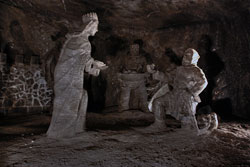
Feastday: July 24
Death: 1292
St. Kunegunda (1224-1292) Daughter of King Bela IV and niece of St. Elizabeth of Hungary, she married King Boleslaus V of Poland at sixteen. On his death in 1279 she became a Poore Clare at the Convent of Sandeck, which she had founded. She also built churches and hospitals, ransomed Christians captured by the Turks, and served the poor and ill. She is also known as St. Kinga. Her cult was confirmed in 1690. Feast day July 24.
Christian saint "Kunegunda" redirects here. For other uses, see Kunegunda (disambiguation).Kinga of Poland (also known as Cunegunda; Polish: Święta Kinga, Hungarian: Szent Kinga) (5 March 1234 – 24 July 1292) is a saint in the Catholic Church and patroness of Poland and Lithuania.
Biography
She was born in Esztergom, Kingdom of Hungary, the daughter of King Béla IV of Hungary and Maria Laskarina. She was a niece of Elizabeth of Hungary and great-niece of Hedwig of Andechs. Kinga's sisters were Margaret of Hungary and Jolenta of Poland. She reluctantly married Bolesław V ("the Chaste") and became princess when her husband ascended the throne as High Duke of Poland. Despite the marriage, the devout couple took up a vow of chastity. The marriage was largely arranged by, and the vow of chastity patterned after that of Bolesław's sister, Salomea of Poland.
During her reign Kinga got involved in charitable works such as visiting the poor and helping the lepers. When her husband died in 1279, she sold all her material possessions and gave the money to the poor. She soon did not want any part in governing the kingdom which was left to her, and decided to become a Poor Clare nun in the monastery at Sandec (Stary Sącz). She would spend the rest of her life in contemplative prayer and did not allow anyone to refer to her past role as Grand Duchess of Poland. She died on 24 July 1292, aged 58.
Veneration
Pope Alexander VIII beatified Kinga in 1690. In 1695, she was made chief patroness of Poland and Lithuania. On 16 June 1999, she was canonized by Pope John Paul II.
Legend
Legend has it that Kinga threw her engagement ring into the Maramures salt mine in what was then Hungary. The ring miraculously traveled along with salt deposits to Wieliczka, where it was rediscovered. On this spot the miners erected a statue of Saint Kinga, carved entirely from salt, which is 101 meters under the Earth's surface.
 Biography portal
Biography portal Catholicism portal
Catholicism portal Saints portal
Saints portal Hungary portal
Hungary portal Poland portal
Poland portal Lithuania portal
Lithuania portal
Sources
- ^ "Katolikus.hu St Kinga". www.katolikus.hu. Archived from the original on 3 March 2016. Retrieved 13 February 2015.
- ^ "St Kinga". Catholic Encyclopedia. 1915. Retrieved 13 February 2015.
- ^ Sokol, Stanley S. (1992). "Cunegunda (Helen)". The Polish Biographical Dictionary: Profiles of Nearly 900 Poles who Have Made Lasting Contributions to World Civilization. Bolchazy-Carducci. p. 74. ISBN 9780865162457.
- ^ Klaniczay, Gábor (2002-03-14). Holy Rulers and Blessed Princesses: Dynastic Cults in Medieval Central Europe. Cambridge UP. pp. 242–43. ISBN 9780521420181.
- ^ Berglund, Bruce R.; Porter, Brian A. (2010). Christianity and Modernity in Eastern Europe. Central European UP. pp. 368 n.61. ISBN 9789639776654.
- ^ "wielizka-mine-an-underground-cathedral-". /www.googobits.com. Archived from the original on 2014-12-05. Retrieved 26 November 2014.
| Wikimedia Commons has media related to Kunigunda of Hungary. |





